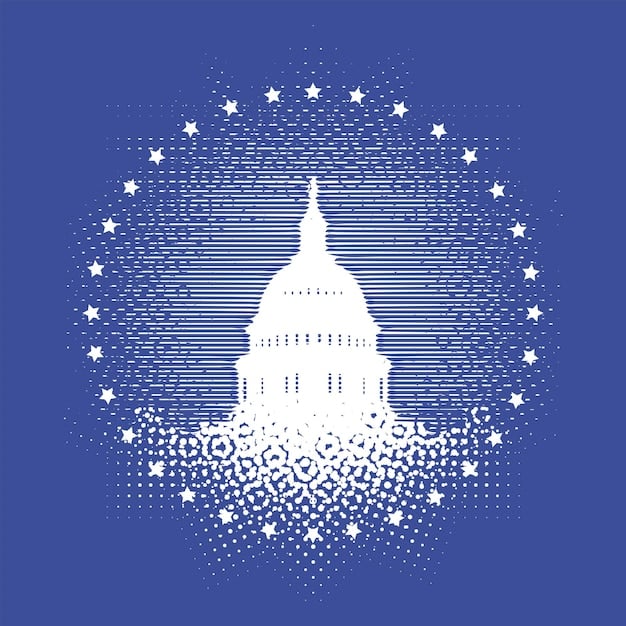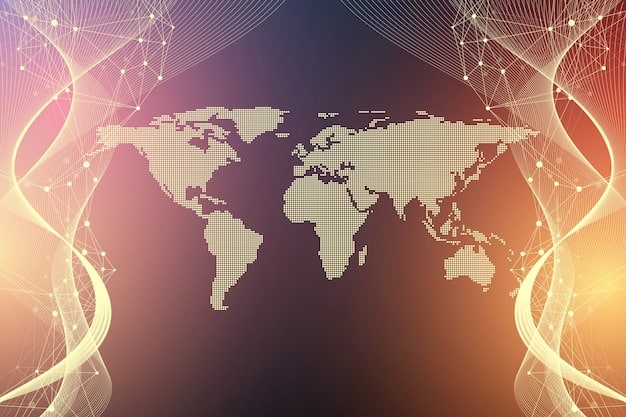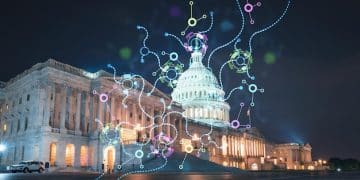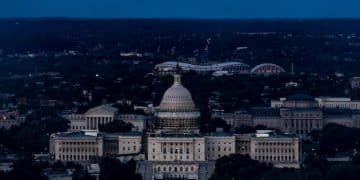US & UN: How Shifting Alliances Shape Foreign Policy 2025

Advertisements
The evolving landscape of global alliances, particularly with nations like China and Russia vying for influence, will significantly reshape US foreign policy in 2025, demanding strategic adaptation and multilateral engagement within and beyond the United Nations framework.
Advertisements
As the geopolitical landscape continues its relentless shift, the intricate relationship between the US and the United Nations: How Will Shifting Alliances Affect American Foreign Policy in 2025? becomes a paramount question. The conventional wisdom surrounding international relations is being challenged by new power dynamics, evolving regional partnerships, and a multilateral system under increasing strain.
The Evolving Global Arena: New Power Centers and Multilateral Challenges
The international system is experiencing a profound transformation, moving away from a unipolar moment towards a more diffuse, multipolar arrangement. This shift is not merely about the rise of new economic powers but also encompasses a re-evaluation of security paradigms, technological supremacy, and ideological influence. Nations are increasingly pursuing foreign policy objectives through flexible, issue-specific coalitions rather than strictly adhering to traditional bloc alignments. This fluidity presents both opportunities and significant challenges for the United States.
Advertisements
Historically, the United States has played a central role in shaping the post-World War II global order, including the establishment and ongoing function of the United Nations. This order was predicated on certain norms, institutions, and the implicit leadership of democratic nations. However, that foundation is now being tested by a variety of factors, from the resurgence of great power competition to the proliferation of non-state actors and global challenges like climate change and pandemics that transcend national borders. The UN, designed for a different era, sometimes struggles to adapt to these new realities.
Geopolitical Realignments and Their Implications
Several key geopolitical shifts are underpinning this evolution. The most prominent includes the assertive rise of China, not just economically but militarily and diplomatically, pushing for a more Sino-centric global order. Russia, despite economic vulnerabilities, continues to challenge the existing security architecture, particularly in Europe. Meanwhile, regional powers in the Middle East, Asia, and Africa are asserting greater independence, diversifying their partnerships, and demanding more equitable representation in global governance.
* The increasing assertiveness of China in global institutions and its Belt and Road Initiative, creating new economic and political dependencies.
* Russia’s willingness to use military force and disinformation to project power and destabilize regions, challenging Western-led norms.
* The growing influence of middle powers like India, Brazil, and South Africa, which often resist alignment with either traditional Western powers or rising authoritarian states.
* The formation of ad-hoc alliances and partnerships focused on specific issues, such as cybersecurity, supply chain resilience, or climate action, bypassing traditional diplomatic channels.
These realignments complicate the traditional framework of alliances, making it harder for the US to rely solely on long-standing bilateral agreements or fixed blocs. It necessitates a more nuanced and agile approach to diplomacy and engagement. The UN, as the primary forum for multilateral discourse, becomes both a stage for these power struggles and a potential mechanism for managing them, provided its member states can overcome their own divisions. The US must navigate this landscape with a blend of steadfast commitment to its values and pragmatic flexibility.
The challenge for US foreign policy in 2025 will be to balance its commitment to multilateralism, often expressed through the UN, with the need to protect its national interests in a fragmented and competitive world. This involves discerning when and how to leverage UN platforms for collective action, and when to pursue alternatives or reinforce alliances outside its immediate purview. It’s a delicate dance between idealism and realism, cooperation and competition, in a world where allegiances are increasingly transactional and fluid. The effectiveness of the US approach will depend on its ability to forge new partnerships while reinvigorating old ones, and to adapt to a global governance structure that is less about hierarchy and more about networked influence.
The United Nations: A Forum for Cooperation, a Stage for Competition
The United Nations remains the indispensable global forum, despite its inherent complexities and limitations. For the United States, the UN serves a dual purpose: it is a vital platform for fostering international cooperation on shared challenges, and simultaneously, a highly visible stage where geopolitical rivalries play out. Navigating these two functions will be critical for American foreign policy in 2025.
On the one hand, the UN’s universal membership and diverse mandates make it uniquely suited to address interconnected global issues that no single nation can tackle alone. From humanitarian crises and peacekeeping operations to climate change mitigation and public health initiatives, the UN facilitates collective action, mobilizes resources, and establishes international norms. For the US, active engagement within the UN allows it to amplify its diplomatic efforts, share burdens, and legitimize its foreign policy objectives on a global scale. It provides a crucial framework for maintaining a semblance of order in a fractured world.
Conversely, the UN also serves as an arena where competing national interests and ideological differences become starkly evident. Member states, particularly permanent members of the Security Council, frequently use the platform to advance their own agendas, block initiatives perceived as threatening, and engage in rhetorical battles. The consensus-driven nature of many UN bodies, coupled with the veto power in the Security Council, can lead to paralysis and frustration, especially when major powers are at odds. For the US, this means contending with opposition from rivals like China and Russia, who often have differing visions for global governance and human rights.
Reforming the UN for a New Era
The imperative for UN reform has never been more pressing, given the current geopolitical climate. Many argue that the UN’s structures, particularly the Security Council, no longer accurately reflect the distribution of global power. Expanding the Security Council to include more permanent and non-permanent members, notably from Africa, Latin America, and Asia, is a long-standing proposal to enhance its legitimacy and effectiveness. However, reaching consensus on such reforms is incredibly challenging, as existing permanent members are reluctant to dilute their influence.
* The debate over expanding the Security Council’s permanent membership to include countries like India, Brazil, Germany, and Japan, reflecting a more diversified global power structure.
* Discussions around reforming the use of the veto power, particularly in cases of mass atrocities, to prevent single nations from obstructing collective action.
* Calls for increased transparency and accountability within UN agencies, ensuring that resources are effectively deployed and mandates are met.
* Modernizing the UN’s bureaucracy and decision-making processes to make it more agile and responsive to rapidly evolving global crises.

The tension between the UN’s cooperative potential and its competitive reality will define its utility for American foreign policy in 2025. The US needs to be strategic in its engagement, focusing on areas where multilateral consensus is achievable and where UN mechanisms are demonstrably effective. Simultaneously, it must be prepared to bypass the UN when necessary, pursuing “coalitions of the willing” or bilateral initiatives if the organization succumbs to gridlock. The key is pragmatic multilateralism – leveraging the UN where it works, and innovating beyond it when it doesn’t. This approach acknowledges the UN’s irreplaceable role while recognizing its limitations in an increasingly complex world. Ultimately, the UN is a reflection of its member states; its effectiveness hinges on their collective political will to prioritize cooperation over narrow self-interest.
The Rise of China and Russia: Reshaping the Global Chessboard
The strategic relationship between the United States, China, and Russia will undoubtedly be one of the most defining features of American foreign policy in 2025. These two nations, often acting in concert or parallel, are actively working to reshape the international order in ways that challenge long-standing US interests and values. Their burgeoning alliances and coordinated diplomatic maneuvering present a complex challenge, demanding a multifaceted and adaptive US response.
China’s rapid economic growth and military modernization have granted it unprecedented global influence. Beijing is increasingly assertive on the world stage, promoting an alternative model of governance and actively challenging US hegemony in various spheres, from trade and technology to regional security in the Indo-Pacific. Its “no-limits” partnership with Russia, while perhaps not an ironclad alliance, signals a significant convergence of interests in counteracting perceived Western dominance and fostering a multipolar world. This collaboration extends to military exercises, energy deals, and diplomatic coordination within international bodies, often aimed at undermining US-led initiatives.
Russia, despite its ongoing conflict with Ukraine and the resulting international sanctions, remains a formidable player, particularly in the energy sector and military hardware. Its willingness to disrupt existing norms and its strategic partnerships in regions like the Middle East and Africa give it outsized influence. Moscow views the US as its primary adversary and seeks to diminish American power through various means, including cyber warfare, disinformation campaigns, and cultivating alternative security arrangements. The alignment with China offers Russia leverage and a crucial economic lifeline, creating a powerful counterweight to the US and its allies.
Strategic Responses from Washington
In response to these shifting power dynamics, US foreign policy in 2025 will likely double down on several interconnected strategies. First, strengthening alliances with traditional partners in Europe and Asia will be paramount, reinforcing collective security arrangements like NATO and deepening cooperation with key Indo-Pacific allies such as Japan, South Korea, and Australia. These alliances serve as vital bulwarks against revisionist powers and provide a foundation for collective defense and diplomatic pressure.
* Enhancing military interoperability and intelligence sharing with NATO allies, particularly concerning Russia’s aggressive posture in Eastern Europe.
* Deepening economic and security ties with Indo-Pacific partners through initiatives like AUKUS and the Quad, aimed at countering China’s expansive regional ambitions.
* Prioritizing diplomatic engagement with nations on the fence, offering alternatives to Chinese Belt and Road investments and Russian security guarantees.
* Investing in domestic innovation and competitiveness to maintain a technological edge, especially in critical areas like AI, quantum computing, and advanced manufacturing.
Second, the US will need to continue investing in deterrence capabilities, both conventional and nuclear, to dissuade aggression from both China and Russia. This involves modernizing its military, maintaining a forward presence in strategic regions, and demonstrating the capacity and will to defend its interests and those of its allies. Third, economic statecraft will be crucial, utilizing sanctions, trade policies, and investment initiatives to manage competitive tensions while seeking areas of potential cooperation where common interests align, such as climate change or arms control – though these remain challenging amidst current geopolitical realities.
Finally, ideological competition will intensify. The US will likely continue to champion democratic values, human rights, and the rule of law, contrasting them with the authoritarian models promoted by China and Russia. This involves supporting civil society, independent media, and democratic movements globally, even as it navigates complex relationships with non-democratic partners vital for strategic interests. The chessboard in 2025 will demand agility, resolve, and a clear-eyed understanding of adversaries’ motivations.
Regional Power Dynamics: New Alliances and Old Rivalries
Beyond the grand chessboard of major power competition, American foreign policy in 2025 will be heavily influenced by the intricate and often volatile regional power dynamics around the world. These dynamics are characterized by the emergence of new alliances, the reassertion of traditional rivalries, and a growing reluctance among some nations to be pigeonholed into singular geopolitical camps. Understanding and skillfully navigating these regional complexities will be crucial for the US to protect its interests and promote stability.
In the Middle East, for instance, the Abraham Accords have reshaped the regional landscape, fostering unprecedented normalization between Israel and several Arab nations. This has created new avenues for cooperation on security and economic fronts, potentially shifting traditional alliances away from a purely Palestinian-centric focus. However, older rivalries persist, notably between Saudi Arabia and Iran, and the ongoing conflicts in places like Yemen and Syria continue to destabilize the broader region. The US must balance its support for emerging partnerships with efforts to de-escalate tensions and prevent proxy conflicts from spiraling out of control.
Similarly, in Africa, a continent often viewed through a narrow lens, geopolitical jostling is intensifying. China’s extensive infrastructure investments and Russia’s growing military and mercenary presence are challenging traditional Western influence. African nations are increasingly asserting their sovereignty, seeking diversified partnerships that serve their own development agendas rather than adhering to Cold War-era alignments. For the US, this means moving beyond a reliance on security assistance and embracing more holistic engagement, focusing on economic development, good governance, and capacity building. This requires a nuanced understanding of each nation’s unique priorities and challenges.
Shifting Alliances in the Indo-Pacific and Beyond
The Indo-Pacific remains a focal point for shifting alliances, driven primarily by China’s assertive rise. The Quadrilateral Security Dialogue (Quad) involving the US, Japan, India, and Australia, and the AUKUS security pact between Australia, the UK, and the US, represent new layers of security cooperation designed to counter China’s growing military footprint and economic coercion. These alliances are not rigid military blocs but flexible partnerships focused on shared concerns, including maritime security, supply chain resilience, and technological cooperation.
* The evolving role of ASEAN (Association of Southeast Asian Nations) as a central, but sometimes fragmented, actor in regional security and economic integration.
* The growing prominence of middle powers in regions like Latin America, pursuing independent foreign policies and seeking to diversify their economic partners beyond traditional strongholds.
* The increasing importance of climate change and energy security as drivers of regional cooperation and, at times, competition, particularly in resource-rich areas.
* The impact of internal political instability and democratic backsliding in various regions, potentially undermining the efficacy of US-backed alliances and initiatives.

Navigating these complex regional dynamics requires a flexible and adaptable foreign policy. The US cannot assume that traditional alliances will hold indefinitely, nor can it impose its will without careful consideration of local contexts. Instead, it must engage in robust diplomacy, tailor its approaches to specific regional needs, and seek out opportunities to build ad-hoq coalitions around shared interests. This involves empowering local partners, supporting regional organizations, and offering credible alternatives to malign influences. The success of American foreign policy in 2025 will hinge on its ability to understand and respond to this multi-layered geopolitical reality.
The Role of Economic Statecraft and Technological Competition
In the evolving landscape of international relations, economic statecraft and technological competition have emerged as central pillars of foreign policy, often surpassing traditional military might in their immediate impact. For the United States, navigating 2025 will require a sophisticated and integrated approach to these domains, recognizing that economic leverage and technological prowess are indispensable tools for shaping global alliances and asserting influence.
Economic statecraft involves the strategic use of economic tools—such as sanctions, trade agreements, investment policies, and development aid—to achieve foreign policy objectives. In 2025, the US will likely continue to employ targeted sanctions against adversaries and malign actors, aimed at disrupting their economic capabilities and deterring undesirable behavior. Simultaneously, it will seek to deepen economic ties with allies and partners through trade agreements and investment initiatives that foster shared prosperity and reinforce geopolitical alignment. The concept of “friend-shoring” or “ally-shoring,” aimed at diversifying supply chains away from adversaries, will gain further traction, reshaping global trade patterns.
However, economic interdependence also presents vulnerabilities. Adversaries can weaponize trade, impose retaliatory tariffs, or disrupt critical supply chains, making economic resilience a key national security priority. The US will need to strengthen its domestic economic foundations, invest in critical infrastructure, and foster innovation to bolster its strategic autonomy and reduce reliance on potentially hostile sources. This balancing act—leveraging economic power while mitigating inherent risks—will be a constant challenge.
The New Battleground: Technology and Innovation
Technological competition has become arguably the most critical domain shaping global power dynamics. Control over leading-edge technologies—from artificial intelligence and quantum computing to advanced semiconductors and biotechnology—will determine economic competitiveness, military superiority, and national security in the 21st century. China, in particular, has made massive investments in these areas, aiming to surpass the US and establish technological dominance. This race for technological supremacy will profoundly influence foreign policy strategy in 2025.
* The battle for global standards in emerging technologies, with nations vying to set the norms and protocols that will govern future digital infrastructures.
* The struggle to secure critical mineral supplies essential for renewable energy technologies, electric vehicles, and advanced electronics, leading to new geopolitical rivalries.
* The increasing use of cyber warfare and intellectual property theft as tools of statecraft, necessitating robust cybersecurity defenses and international cooperation to deter such activities.
* The development and deployment of dual-use technologies (civilian and military applications), complicating export controls and non-proliferation efforts.
For the US, success in technological competition will require a concerted effort on multiple fronts. Domestically, this means sustained investment in research and development, fostering a vibrant innovation ecosystem, and ensuring a skilled workforce. Internationally, it involves forging “tech alliances” with like-minded nations to share research, establish common standards, and collectively protect sensitive technologies from adversarial appropriation. Export controls on critical technologies will be tightened, and efforts to restrict the flow of advanced components to strategic competitors will intensify. The convergence of economic statecraft and technological competition underscores a fundamental shift in foreign policy: power is increasingly measured not just by military might, but by economic resilience and technological leadership. In 2025, the US will need to strategically integrate these elements to maintain its global leadership and secure its interests in a rapidly evolving world.
Domestic Politics and Public Opinion: The Home Front’s Influence on Foreign Policy
The formulation and execution of American foreign policy are inextricably linked to domestic politics and the prevailing currents of public opinion. In a democratic system, the will of the people, as expressed through elections, advocacy groups, and media narratives, exerts significant influence on how the United States engages with the rest of the world. In 2025, this interplay between the home front and international affairs will be particularly potent, shaping the degree of consensus or division on critical foreign policy choices.
A polarized domestic political environment can severely constrain a president’s ability to forge a coherent and consistent foreign policy. Deep divisions within Congress on issues ranging from trade agreements to military interventions can lead to legislative gridlock, undermine America’s credibility abroad, and make it difficult to sustain long-term commitments. The rise of nationalism and isolationist sentiments in some segments of the electorate also challenges traditional bipartisan support for international alliances and multilateral engagement. This necessitates careful internal diplomacy and coalition-building by the Executive Branch to ensure sufficient domestic backing for its international agenda.
Public opinion, shaped by a diverse and often fragmented media landscape, also plays a crucial role. Historical events, economic conditions, and social movements can rapidly shift public sentiment towards or against specific foreign policy approaches. For instance, a struggling economy might decrease public appetite for foreign aid or military spending, while a perceived national security threat could galvanize support for assertive action. The challenge for policymakers is to educate the public, articulate the national interest in a compelling manner, and manage expectations in an increasingly complex and interconnected world.
The Influence of Non-State Actors and Special Interests
Beyond traditional political parties and voters, a wide array of non-state actors and special interest groups actively seek to influence US foreign policy. Think tanks and academic institutions provide research and analysis, often shaping the intellectual discourse surrounding international issues. Advocacy groups, ranging from human rights organizations to industry associations, lobby extensively for policies that align with their specific agendas, bringing significant financial resources and grassroots support to bear.
* The growing influence of social media and online movements in shaping public narratives about international events, often bypassing traditional gatekeepers and accelerating the spread of information, or misinformation.
* The role of the defense industry and other powerful economic lobbies in advocating for specific military spending priorities and arms sales policies.
* The impact of diaspora communities on US foreign policy decisions, particularly concerning their countries of origin, often mobilizing voters and lobbying elected officials.
* The rise of “citizen diplomacy” and transnational movements addressing global issues like climate change or public health, pressuring governments to adopt more ambitious international commitments.
In 2025, the ability of foreign policy leaders to build and sustain a strong domestic consensus will be vital. This involves not only effective communication but also demonstrating how international engagement directly benefits the American people, whether through economic prosperity, enhanced security, or the promotion of shared values. Neglecting the home front risks undermining even the most meticulously crafted foreign policy strategies, leaving the US vulnerable to internal divisions that project weakness on the global stage. Ultimately, American foreign policy is a reflection of its domestic health, making it imperative to address challenges at home to project strength abroad.
The Future of American Foreign Policy: Adaptability and Pragmatism
As we look towards 2025, American foreign policy stands at a critical juncture, facing a tapestry of shifting alliances, emergent power centers, and pressing global challenges. The past is no longer a reliable template for the future. The traditional paradigms of rigid blocs and clear-cut adversaries are giving way to a more fluid, multipolar world that demands unprecedented levels of adaptability and pragmatism from the United States. The era of unilateral dominance is over, replaced by an imperative for strategic collaboration and nuanced engagement.
One of the defining characteristics of future American foreign policy must be its embrace of “flexible geometry” in alliance building. Rather than relying solely on fixed, permanent alliances, the US will increasingly need to cultivate purpose-driven coalitions tailored to specific issues, whether it’s countering cybersecurity threats, addressing climate change, or ensuring supply chain resilience. These “coalitions of the willing” may involve diverse partners, some traditional allies, others non-aligned nations, centered on shared interests rather than ideological uniformity. This approach maximizes leverage and spreads the burden of collective action.
Furthermore, the US will need to refine its approach to great power competition, particularly with China and Russia. This involves a delicate balance of robust deterrence, strategic competition in key domains like technology and economics, and conditional cooperation on global issues where mutual interests align. Complete decoupling is often unrealistic and counterproductive; instead, a policy of “de-risking” that focuses on reducing vulnerabilities while maintaining engagement where beneficial is likely to prevail. This requires clear communication, consistent resolve, and a willingness to explore limited areas of common ground.
Reinvigorating Multilateralism and Domestic Strengths
The United Nations, despite its imperfections, remains an essential global institution. American foreign policy in 2025 must focus on pragmatic multilateralism: actively engaging within the UN to push for reforms that enhance its effectiveness, leveraging its platforms for consensus-building on global challenges, and using its forums to defend international law and norms. This does not preclude acting outside the UN when necessary, but it recognizes the unique legitimacy and reach that only a universal body can provide. Investing in the UN’s capabilities reinforces a rules-based international order that generally favors US interests.
* Prioritizing diplomatic initiatives that foster de-escalation and confidence-building measures in volatile regions, preventing smaller conflicts from escalating into broader confrontations.
* Investing in public diplomacy and counter-disinformation efforts to promote American values and counter adversarial narratives in the global information space.
* Strengthening international law and norms, particularly related to cyber warfare, space, and emerging technologies, to ensure responsible state behavior.
* Rebuilding and nurturing the domestic foundations of American power, including economic competitiveness, social cohesion, and democratic resilience, as these are prerequisites for effective foreign policy.
Ultimately, the future success of American foreign policy hinges on its internal strength and its capacity for self-renewal. A strong, cohesive, and resilient America at home is the most potent tool for projecting power and influence abroad. This means investing in education, infrastructure, scientific research, and addressing societal divisions. Only then can the US confidently navigate the complexities of shifting alliances, embrace pragmatism, and lead effectively in a world that is less about static alignments and more about dynamic adjustments. The coming years will be defined by an agile foreign policy that is both globally engaged and domestically grounded.
| Key Point | Brief Description |
|---|---|
| 🔄 Global System Shift | From unipolarity to multipolarity, demanding agile US diplomatic adaptation. |
| 🤝 UN’s Dual Role | Cooperation forum and competition stage for major powers, necessitating pragmatic US engagement. |
| ⚔️ China-Russia Axis | Deepening partnership challenging US interests, requiring strengthened alliances and deterrence. |
| 💡 Economic & Tech War | Economic statecraft and tech supremacy are key battlegrounds, demanding innovation and strategic alliances. |
Frequently Asked Questions about US Foreign Policy in 2025
▼
The growing assertiveness and coordination between China and Russia will likely spur the US to strengthen existing alliances, such as NATO and those in the Indo-Pacific, while also forging new, flexible partnerships tailored to specific threats or shared interests. This dual challenge necessitates a more robust and adaptable alliance strategy from Washington.
▼
The UN will remain a critical, albeit complex, platform. For the US, it will serve as both a forum for necessary international cooperation on global issues like climate change and a stage for geopolitical competition with rivals. The US will likely pursue pragmatic multilateralism, engaging where the UN is effective and exploring alternatives when it faces gridlock.
▼
Economic statecraft, including sanctions, trade agreements, and investment policies, will be paramount. The US will use these tools to achieve foreign policy objectives, influence global supply chains (e.g., friend-shoring), and bolster its economic resilience against potential adversaries. Its importance will continue to grow as economic influence expands as a tool of power.
▼
Absolutely. Domestic political polarization, public opinion, and the influence of various non-state actors will heavily shape US foreign policy. A deeply divided home front can limit a president’s ability to enact consistent international strategies and undermine America’s credibility and capacity to project strength on the global stage.
▼
Key challenges include navigating a truly multipolar world, managing complex relationships with both allies and adversaries, adapting to rapid technological change, and maintaining domestic consensus in a polarized environment. Success will require pragmatic decisions, flexible alliance-building, and consistent investment in both internal and external strengths amidst rapid global shifts.
Conclusion
The geopolitical landscape slated for 2025 presents a complex mosaic for US foreign policy, one where traditional certainties are replaced by dynamic shifts and intertwined challenges. From the assertive rise of China and Russia to the fluidity of regional alliances and the increasing potency of economic and technological statecraft, the United States faces an imperative for profound adaptability and pragmatic engagement. Its ability to navigate these currents, leveraging the United Nations where appropriate while forging flexible, issue-specific coalitions, will determine its capacity to safeguard its interests and promote stability in a world that continues to redefine international order.





